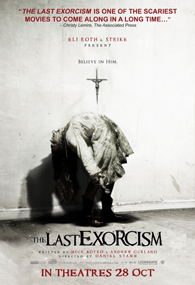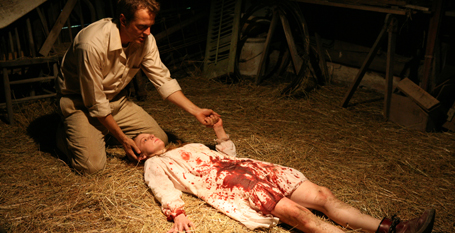
He’s not a conman but what he does is, despite his honest intentions and holy purposes – a con. This backstage moment fulfils two functions in this horror fake documentary. It’s a witty and sarcastic aside to the audience – these people think they’re bloody smart, do they? Wait till they find out there’s really a demon! The whole idea of a found footage film is to have the smug filmmakers succumb to what they do not believe in (The Blair Witch Project, Cannibal Holocaust) on camera at the end. Yet at the same time, this double aside (the shared moment between the reverend and the audience, and between the script and the audience) itself signals a metatextual wit pioneered in F For Fake by Orson Welles and then resurrected by Wes Craven in his horror films.
Yet maddeningly, the film cuts between the bedroom where the reverend is doing his preparation work and the outdoors a few hours prior to the preparation in the bedroom, where the reverend does the show and tell for his documentary crew. You see, if this is a found footage film, a fake documentary where the entire film crew dies at the end, where did they have the time to edit the footage they just shot barely a few hours ago?
This sequence therefore is also emblematic of how the film hints at its potential greatness and then squanders it away almost immediately. Other errors abound: despite this being a fake documentary, horror film sound effects (clashing chords, actual non-diegetic music) happen with the ‘real horror’ begins, establishing shots are used to set up scenes when the cameraman of the documentary couldn’t possibly have been there, footage obviously shot with two cameras when there’s only one cameraman in the story, and so on. All this tend to puncture the aura of believability and dramatic tension that the script attempts to build up. And for the fake documentary genre, it is all about believability.












 Printable Version
Printable Version










Reader's Comments
Be the first to leave a comment on this page!
Please log in to use this feature.